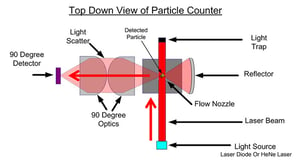Flow rate is important to consider when selecting a particle counter for a critical environment. The flow rate of a particle counter is the rate at which a pump draws air through the sample chamber, measured in cubic feet per minute (cfm). Two common flow rates for particle counters are 1 cfm and 0.1 cfm. Depending on the application, each flow rate can be valuable.
1 cfm versus 0.1 cfm
Let's think about it this way: the highway versus the back roads. If you're going to take a long trip or have a schedule to stick to, you'll want to take the highway. But if you're just running to th e store a couple streets over, you would take the back roads.
e store a couple streets over, you would take the back roads.
In terms of cfm, a particle counter with a 1 cfm flow rate is like taking the highway. Its higher flow rate allows for a faster sample collection. A particle counter with a 0.1 cfm flow rate is like taking the back roads. It can achieve the same results in applications where time is not a constraint.
Flow rate does play a significant role in how quickly a particle counter performs its job, but it is important not to ignore the sensitivity of the particle counter. If a particle counter isn't sensitive enough to measure small particles as specified in the ISO Classification of the particular critical environment, then the flow rate doesn't matter.
Applications for Each Flow Rate
The current standard for particle counting requires a sample of 1 cubic meter. For an inspector, then, a 1 cfm flow rate makes sense. A 1 cfm flow rate would allow an inspector to collect the sample information they need in just over half an hour. A flow rate of 1 cfm means an inspector can collect samples from all the areas they need to within their schedule.

However, an employee doing a spot check or a continuous monitor in a space doesn't require the same amount of power. A technique called sequential sampling allows the total required volume to be divided into equal parts and essentially the proportion of required particles is equally divided throughout each portion. A large sample volume does not have to be sampled if the sub-samples show sufficient evidence of cleanliness. With sequential sampling, a particle counter with a 0.1 cfm flow rate, like Setra's 8000 series handheld, can be used to ensure a clean room or other critical environment meets standards during a spot check.
For continuous monitoring of a space, Setra's 7000 series AQM is ideal. A particle counter and environmental monitor with a flow rate of 0.1 cfm, the 7000 series AQM is the most versatile remote air quality monitor available. When integrated into a building automation system, a 0.1 cfm particle counter can provide continuous monitoring without the need for a higher flow rate.


